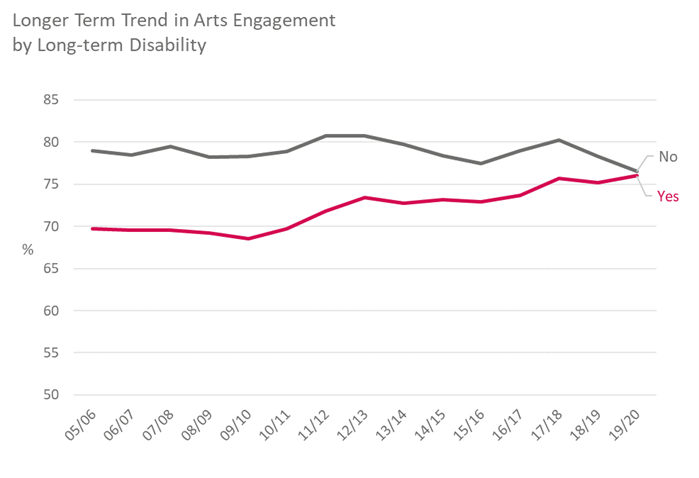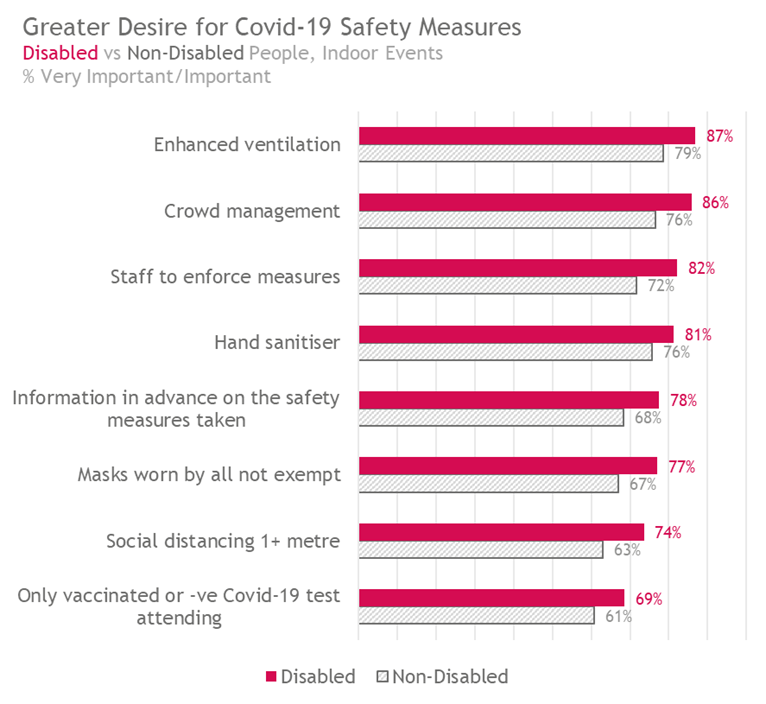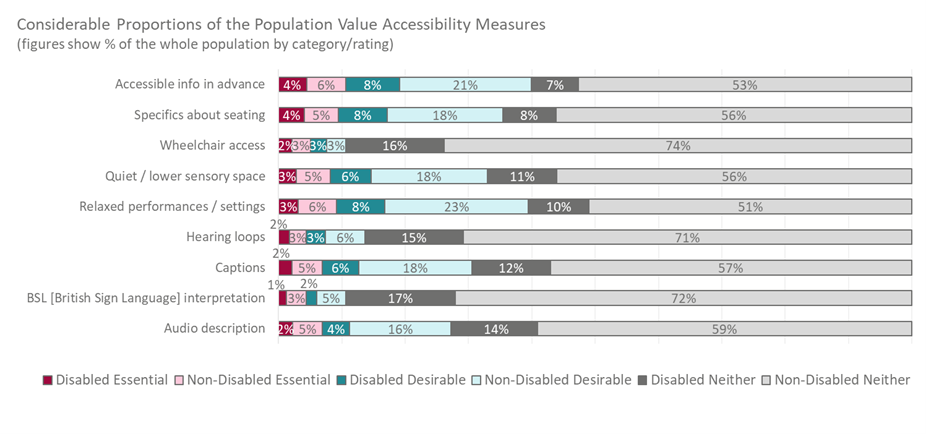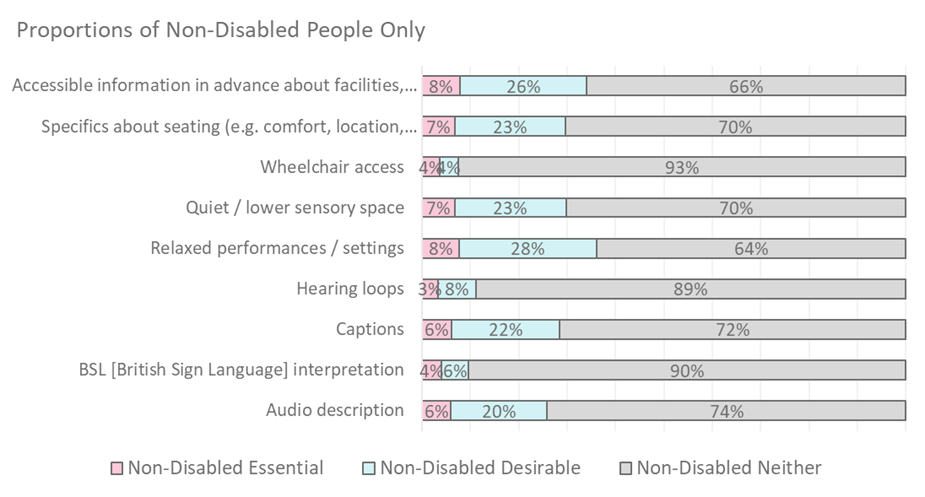Safeguarding Disabled Audiences' Future Engagement
August 2022
Contents
Themes
Despite calls for inclusive reopening from a range of advocates and advocacy groups, disabled people are at risk of being ignored within the wider desire to return to normal.
In every aspect, disabled people have been disproportionately affected by the pandemic, and cultural engagement has been no exception. Despite the challenge of the past few years revealing the sector's ability to provide audiences with myriad accommodations when the need strikes as sufficiently urgent, there is concern that these lessons are not being carried forward into a culture of prioritising greater accessibility in general as audiences return.
In this article , The Audience Agency's Head of Evidence, Oliver Mantell, and Chief Executive of VocalEyes, Matthew Cock, talk through:
During Covid-19, the cultural sector has shown the extent to which changes to format, provisions, platforms and other accommodations have been possible, when the need is felt to be sufficiently urgent. Based on evidence from the Cultural Participation Monitor (Wave 6, from late March 2022) we argue that the needs of disabled audiences should continue to be treated as of urgent importance. The challenges for disabled people remain significant, but greater equality of access is possible.
The Urgency
Disabled people have been adversely affected by Covid-19 more than many other groups of the population, with greater impact on health, well-being, income and ability to go about their daily lives without restriction. Culturally too, disabled people have faced greater challenges. And as many audience groups return to in-person engagement, this cultural disparity is becoming only more evident. Despite calls for inclusive reopening from a range of advocates and advocacy groups (notably through the UK Disability Arts Alliance’s campaign We Shall Not Be Removed), disabled people are at risk of being ignored within the wider desire to ‘return to normal’.
During Covid-19, the cultural sector has shown the extent to which changes to format, provisions, platforms and other accommodations have been possible, when the need is felt to be sufficiently urgent. Based on evidence from the Cultural Participation Monitor (Wave 6, from late March 2022) we argue that the needs of disabled audiences should continue to be treated as of urgent importance. The challenges for disabled people remain significant, but greater equality of access is possible.
The Context
The arts sector has made notable improvement over a number of years in terms of engagement with disabled people. Back in 2005/6, there was a 9.2 percentage point gap in the proportion who had engagement with arts during the previous 12 months between those with and without a self-defined ‘long-term illness or disability’. By 2019/20 this had shrunk to just 0.5 [based on Taking Part data, as well as definitions of ‘the arts’]:

Put simply, disabled people were then just as likely to engage with the arts as non-disabled people. Evidence from the Cultural Participation Monitor confirms that the arts have achieved greater equality between disabled and non-disabled people than several other areas of interest. While there is little or sometimes a positive difference with cultural and creative activities, interests like taking part in sport or exercise, or travel and holidays, have significant under-representation of disabled people. Any decrease in equality of engagement in the arts therefore reverses recent progress in an area in which a relatively greater level of equality had been achieved.
The Impacts of Covid-19
The difference in impacts of Covid-19 for disabled people have been greater in a wide variety of ways, both in their general lives and relating to arts and culture.
Covid-19 and wider life impacts
The impact of Covid-19 on disabled people can be shown in terms of changes to overall life satisfaction, as well as in terms of specific impacts. For example, when asked whether they are more or less satisfied with life compared to before the pandemic, 41% of disabled people said ‘less satisfied’ compared to only 31% of non-disabled respondents. One more specific measure that may impact this is whether people feel they are better or worse off financially compared to pre-pandemic. Again, there is a 10 percentage point difference, with 45% of disabled people say they are ‘worse off’ compared to 35% of non-disabled people. Similarly, as the cost of living begins to dramatically rise, 41% of disabled people say their spending on entertainment or leisure versus pre-pandemic will decrease, compared to 31% of non-disabled people.
In terms of work, while in the pandemic overall trends are similar for the proportion of people working from home, disabled people have higher proportions working from home ‘all the time’ (despite being no more likely to have been working from home ‘more than before’: this was a pre-existing difference). When there is ‘no threat from Covid-19’, 32% expect to always work from home (compared to 20%) and 40% prefer always working from home when only 28% of non-disabled people do. Measures to support home working disproportionately benefit disabled people; likewise changes to engagement patterns caused by working from home (e.g. more local attendance) are also more likely to apply to disabled audiences.
Cultural attendance and attitudes to risk
While among the population as a whole willingness to attend is growing, and people are less keen on Covid-19 measures compared to November 2021, disabled people have consistently different numbers on those measures. 30% of disabled people agree or strongly agree that their attendance of cultural events is back to normal, compared to 40% of non-disabled people, and only 29% are now happy to attend a cultural event without reservations, compared to 41%. A third also expect to attend (for example) a live performance less regularly in the future, while only a quarter of non-disabled people do. This suggests that the gap in engagement levels between disabled and non-disabled people is liable to widen again post-pandemic.
Potential causes are easy to identify. These differences may be heavily influenced by the different assessment of Covid-19 risks and measures put in place that disabled people make. Generally, 60% are worried about falling ill with Covid-19 (compared to 43% of non-disabled people). Behind this overall figure, however, there are substantial differences by age. When we compare responses of those who are disabled and non-disabled of the same age, we see that for those aged 16-24, the figures are 42% of disabled people who are worried, compared to 30% of non-disabled people (younger people are at lower risk on average for both groups). For over 65s, the corresponding figures are 62% and 52% (all older people are at enhanced risk). The difference is most evident among those aged 25-64, at 62% compared to 43%.
Similarly, 61% say we should do everything we can to reduce catching/spreading the virus, compared to less than half of non-disabled people. Within this second group, the proportion of those who have impaired breathing or mobility is nearly 70%. In indoor cultural events, nearly half of disabled people assess the risk from Covid-19 as high or very high, compared to only 36% of the non-disabled population.
Safety measures
This greater sense of risk is probably why disabled people are more likely to rate various Covid-19 safety measures as very important/important. For indoor events, measures such as crowd management, social distancing and wearing masks are rated as very important/important by around 10 percentage points more of disabled people, with around three quarters of disabled people saying this. This rises to 87% for enhanced ventilation as a specific measure.

Overall, 58% of disabled people would be less confident to attend events if all measures were removed, compared to 42% of non-disabled people, but this rises to 65% among those who have impaired breathing or mobility.
Access measures
There is widespread endorsement of the need or desirability of various access measures among disabled people. Notably, however, their benefit also extends to substantial numbers of those who don’t consider themselves disabled or affected by a long-term health condition. The following chart summarises the proportions of all respondents who consider each accessibility measure listed either essential (dark/light pink), desirable (dark/light blue) or neither (dark/light grey) for their attendance, with the intensity of colour differentiating between those who are disabled (darker) and non-disabled (lighter). The figures for this and the next two charts are also given in the following tables.

The following charts then focus on disabled/non-disabled people only, showing the proportions within that category giving each response.


In all cases, a higher proportion of disabled people consider measures ‘essential’ or ‘desirable’ compared to non-disabled people. In most cases, however, a far larger absolute number of non-disabled people also consider these measures ‘essential’ or ‘desirable’. To take one example: for captions, around twice as many disabled people say it is essential (11% compared to 6% of non-disabled people), but the gap is closer in those saying it is desirable (28% compared to 23%).
Thus, although these measures are most important for disabled people, their application is even broader, with most being at least ‘desired’ by more than a third of the population. The two measures showing the highest response rates are ‘Accessible information in advance about facilities’, essential or desirable to 47% of the population overall, and ‘Relaxed performances / settings’ essential or desirable to 49%. These both give weight to the decision by Battersea Arts Centre to launch themselves in February 2020 as the world’s first Relaxed Venue, which takes the principles that guide Relaxed Performances and applies them across all of an organisation’s spaces and programmes, encompassing everything from clear, understandable advance information, to taking a relaxed approach to movement and noise coming from the audience.
Value of online
Disabled people already had slightly higher online engagement with arts and culture in the year before Covid-19 (43% having done one or more of the list of online activities, compared to 40% of non-disabled people) and were also slightly more likely to have increased their engagement during the pandemic (41% of disabled people, compared to 35%). It is perhaps, however, worth noting that only those with vision/speech/memory/hearing impairments were notably more likely to say that they were engaging online more during the pandemic. We also saw substantially higher levels of online engagement among those who identified as neurodivergent compared with those who did not (66% had done any of the online activities listed in the year before Covid-19, compared to 38%, although this may in large part reflect the younger age profile of those who identified as neurodivergent).
Nearly half of disabled people took part in an online arts or heritage activity of some kind, a few percent more than non-disabled people. This pattern was also seen for specific online activities. For example, 30% of disabled people watched an online music/performance stream or recording (compared to 27% of non-disabled people). Since 25% were doing this before the pandemic this is not a big shift in behaviour, matching the increase seen in non-disabled online engagers. Disabled people were, however, more likely to have seen a performance or taken a tour online from a local organisation rather than a national one.
In both disabled and non-disabled groups, when there is no threat from Covid-19 around one third of people say they will do online activities most or some of the time instead of in-person.
The Cultural Participation Monitor
The COVID-19 Cultural Participation Monitor began as a major population research study that was part of a national research programmeled by the Centre for Cultural Value in collaboration with the Creative Industries Policy and Evidence Centre and The Audience Agency. This Wave of the monitor is supported by VocalEyes. The monitor covers the whole population, meaning that these findings provide a wider view than — and helpful context for — research focused purely on current users. These findings are from Wave Six of the Monitor, with fieldwork taking place online from 14 March 2022 to 24 March 2022. There were 3,197 responses selected using quotas for age, gender, ethnicity, region and Audience Spectrum (The Audience Agency’s arts-based profiling model), weighted to ensure representativeness. 647 respondents said they ‘identified as a D/deaf or disabled person or have a long-term- health condition’.
Notes on the Research
In our research we asked people to self-define as D/deaf, disabled or with a long-term health condition, and this group was compared to those who answered ‘no’ to this. We further asked, ‘Which of the following describe that impairment or health condition?’ with respondents able to tick as many as applied: Impaired vision, partial sight or blindness; Impaired hearing, partial hearing or deafness; Breathlessness or chest pains; Find it difficult, or are unable to walk, stand or move; Find it difficult, or are unable to speak; Dementia or memory loss; Anxiety/depression; Other mental health condition(s); Other impairment/health condition. Where relevant we have highlighted differences in responses by these categories, individually or grouped (e.g. ‘sensory impairments’)
We would ordinarily advocate for use of a social model of disability: i.e. ‘disability’ being the result of the interaction between an individual and their social context — a reflection of an unmet need, rather than a description of the individual themselves. In this instance, however, since we both wished to look at the extent to which needs are met and also compare with external benchmarks (such as Taking Part) we have based the research on self-definition.
